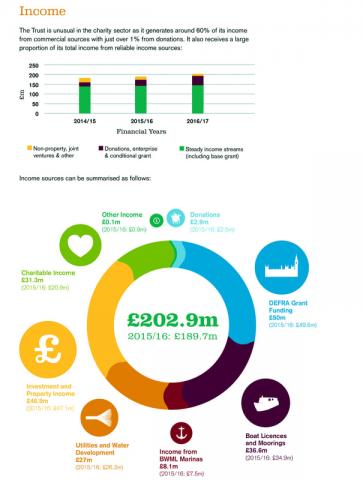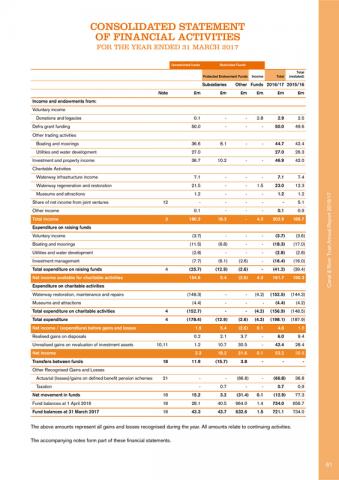Is a new logo enough to close C&RT's financial black hole?
March 2018 - Why does Canal & River Trust appear to be floundering and making changes which begin to look a lot like desperation? Just five years in, it is changing everything from its internal structures to boat licences and even selling off marinas – to say nothing of yet another corporate identity. Peter Underwood has been taking a long look at what lies behind the incessant urge to change.
The Canal & River Trust was born out of a Tory Prime Minister's urge to create what he called a 'third sector solution'. The problem he was 'solving' was government's financial responsibility for a national asset of global importance – the British waterways.
David Cameron wanted to privatise the waterways but could not go as far as selling them to commercial interests as there was no private sector appetite for sustaining them as navigations. His solution was to pass them to a charity, not a proper charity, but one created by government and unaccountable to members or users.
In the preceding decade, under British Waterways, there had been unprecedented investment in the waterways, often with lottery cash, that saw major restorations like the Rochdale and Huddersfield canals.
Yet, with the active help of British Waterways executives, who argued that it would be even easier to access lottery funds and local authority cash and the alternative was ever-shrinking budgets within the public sector, C&RT was established. It was a sort of low key tribute to the neo liberal view of economics that wanted to avoid tax money going to public sector work.
The sweetener was an annual grant from Defra of £40m a year with an extra £10m if C&RT met certain targets.
The sting in the tail was that that additional £10m starts to decrease year by year after 2022 and the grant itself ends in 2027 with no guarantees there will ever be any more cash from government.
Five years on, and 2022 looks alarmingly close and 2027 not that far away – and that is what underlies all the frantic management efforts to re position C&RT in the public mind.
Despite the relentlessley upbeat annual reports and public relations campaigns, the reality is that the Trust is not even close filling the £50m black hole that the loss of tax cash will leave; and many of its fund raising efforts have fallen flat. The Friends of C&RT scheme has yet to break even over its lifetime, and the now-scrapped Waterways Partnerships cost hundreds of thousands of pounds a year and failed to raise a single penny, for example.
It is difficult to avoid the conclusion that chief executive Richard Parry and his Trustees have come to the conclusion that the only replacement for Government money is more Government money and all the signs of a shift away from C&RT being a waterways charity to being something more relevant to many more people are already there.
Lat year's annual report said: “Our vision now is for living waterways that transform places and enrich lives. To achieve this, we want to release our canals and rivers’ potential as catalysts again – especially in those areas that need it most.”
At the same time the Trust spent another tranche of money on an expensive academic report on the impact of waterways on people's 'well-being' and well-being has become the new C&RT buzz-word.
Richard Parry, once very concerned to be seen as the boaters friend, has almost disappeared from view as far as boaters are aware, and even fails to intervene when the Trust's reputation with volunteers and canal users is badly damaged – as his refusal to do anything about the shameful treatment of Colin Ogden's Lanky Boaters adoption illustrates.
His concern is no longer boaters or perhaps even navigation – it is bringing many more of the 25 million people claimed to be living near C&RT's waterways into the equation and using them as a lever to extract more government cash after cuts begin in four years time.
Given that the current C&RT image has not achieved that, as the figures for Trust 'friends' and other donations amply illustrate, it should be no surprise to boaters that their needs are being overtaken by the urgent need of C&RT bosses to make a case for a large lump of government money for all the good work they claim waterways do in improving the health and well-being of non-boaters.
Boater owners tend to see everything through the lens of their own requirements, naturally enough, and the announcement of the redesign of the C&RT image coincided with the Middlewich embankment collapse – with the cost estimates of both rumoured to be around £2m.
It was inevitable that many boaters drew the comparison and expressed trenchant views – but it was probably mistaken.
To begin with C&RT insists the rebrand came out of it's existing marketing budget and eventually its public relations staff came up with a figure of £60,000 rather than £2m. Jonathan Ludford told The Floater: “This year we have spent some of this marketing budget on developing our brand, which included testing with market research groups and developing logo and design guidelines. The spend for this activity is estimated at around £60k, so nowhere near £2 million.
“As we’ve said, there is no new marketing budget for this and we are not taking any money away from maintenance spend. I don’t have a figure for the next 2-3 years, but it will be mainly on a replacement basis, so again no new money.”
Perhaps the question boaters might be asking is whether this is enough to turn around the failures of the past in presenting C&RT to a public which seems largely indifferent to the appeal of keeping canals and rivers as working navigations.
Unfortunately, because of the decision to remove direct national accountability for our waterways from Government and place it in the hands of a soon-to-be inadequately funded pseudo charity, boaters are set to suffer as the funds dry up.
Even with the planned increase in licences, and given that there will no longer be an income from BWML as it is being sold, boaters will contribute less than £40m a year to C&RT coffers.
There is some scope for increased income from investments and donations but, even on best estimates, the only real way of sustaining current spending would be to load the burden on the boaters who use the system.
It is not unrealistic to estimate that would require a doubling of licence and mooring fees.
Given that we are lumbered with the very imperfect C&RT organisation, and there is currently no realistic prospect of returning the waterways to the public sector, where they belong, it may seem that the £60,000 or even more spent on a new logo is small beer by comparison with a doubling of boating costs.
Richard Parry's strategy is risky and there are no guarantees that the current C&RT has the ability to generate widespread appeal and awareness. He is gambling that a future government, of an unknown political persuasion, can be convinced to hand over millions on the basis that waterways are good for everyone.
Photos: (1st) 2016-17 Annual Report - shows how income is split, (2nd) 2016-17 Annual Report pins down the numbers, (3rd) Richard Parry - no longer focused on boaters.








